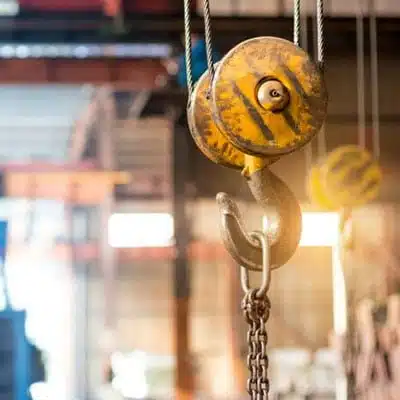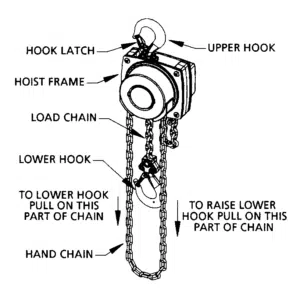Hoists
What Is A Hoist? (Components, Types, History, Choosing)
A hoist is a machine specifically designed to raise and lower loads that are too heavy for manpower alone. Hoists have a drum or wheel around which wraps either a chain or rope that controls whether the load is raised or lowered.

Initial Thoughts
Hoists come in all shapes and sizes. But what is a hoist? This article will uncover the definition of a hoist, the various types of hoists, the difference between hoists and cranes, and finally, some tips for purchasing a hoist. So let’s get to it.
Some hoists lift a lot of weight (over 50 tons!) and some lift fewer than 100 pounds. They truly come in all shapes, sizes, and purposes. However, there are many components that all hoists have in common.
What Are The Components Of A Hoist?
Some components are unique to certain hoists. For example, electric-powered hoists have no use for the lever that manual-powered lever hoists have.
However, all hoists must have certain characteristics in order for them to claim the name ‘hoist.’ For example, all hoists have a load chain/rope, a lower hook, and a lifting/lowering mechanism. Let’s look at the other components of a hoist.

- Upper Hook – The hook that attaches the hoist to its support system (crane or beam).
- Lower Hook – The hook that attaches to the load that requires lifting.
- Hook Latch – A safety mechanism that locks the hook onto its attachment.
- Load Chain/Rope/Wire Rope – Connects the lower hook to the lifting mechanism.
- Drum & Rope Guide – Guides and wraps the chain/rope as it lifts/lowers its load.
- Lifting/Lowering Mechanism – The gear and pulley mechanism.
- Hoist Frame – Contains the lifting mechanism.
What’s The Difference Between A Hoist And A Crane?
Hoists lift objects vertically (up and down) while cranes are capable of maneuvering vertically and horizontally (forward and back). However, cranes and hoists are often two parts of the same system.
One of the most common misunderstandings, when people are learning about hoists and cranes, is the difference between the two. Hoists & cranes often work together to achieve the same goal: to lift or lower something.
Typically, a hoist provided 1-Dimensional movement as it goes up and down. However, when a hoist is mounted on a crane, it allows for 2-Dimensional or 3-Dimensional movement. Therefore, the combined hoist & crane system has much greater flexibility than either machine acting alone.
Types of Hoists
There are several types of hoist devices. Most hoists are electric-powered, but they can also be pneumatic (air-powered) or manually operated. Let’s go through each hoist type to more thoroughly understand what exactly a hoist is and how they are used.
What Is A Manual Hoist?
Manual chain hoists are lifting devices that are powered by lever-action or a hand chain as opposed to some power source. They require someone to physically raise and lower them, thus the term: manual hoists.
Operating a manual hoist, i.e. raising or lowering the load, is done by cranking a lever attachment or by pulling either end of the hand chain.
Manual chain hoists are not ideal for every scenario. However, there are plenty of situations where a manual hoist is the best solution. Let’s review some advantages and disadvantages of using manual hoists over a powered hoist.
Advantages of Manual Hoists
- Very portable
- Low maintenance compared to other types
- Many options to choose from
- Small purchase cost
- Great for use in hazardous areas
- Only requires manpower, not electricity or air
Disadvantages of Manual Hoists
- Lower lift height than powered hoists
- Requires a little manpower
- Not always a permanent solution
Manual Hoists For Sale
We have a large selection of manual hoists for sale. These can be customized to lift various capacities, lift heights, and more, including accessories.
What Is An Electric Hoist?
Electric hoists are lifting devices that are powered by electricity and utilize chains or wire rope to lift and lower objects. Instead of having to manually crank a lever or pull a chain, the operator of an electric chain hoist need only push a button to raise or lower their cargo.
Just as manual chain hoists are not ideal for every scenario, electric chain hoists have pros and cons. Ultimately, the choice to purchase this type of hoist will depend on your intended use case. Let’s look at those pros and cons.
Advantages of Electric Hoists
- Electricity is inexpensive and available
- Productivity, ergonomics, and safety are enhanced
- Highly portable
- Highly configurable
- Provides true vertical lift
Disadvantages of Electric Hoists
- Requires electricity
- Requires more maintenance than manual hoists
- More expensive than manual hoists
- Not the best in dangerous environments
Electric Hoists For Sale
We have a large selection of electric-powered hoists for sale. These can be customized to lift various capacities, lift heights, and more, including accessories.
What Is A Pneumatic/Air Hoist?
Air hoists, also known as pneumatic hoists, are lifting devices powered by compressed air. Instead of cranking as you would a manual hoist or connecting it to a circuit, pneumatic hoists instead connect to an air compressor that powers the device.
Air-powered hoists are the perfect choice for certain situations but not for others. With that said, let’s take a look at some of the advantages and disadvantages of air hoists.
Advantages of Air Hoists
- Explosion-proof
- Self-cooling
- Easier to repair than electric hoists
- Can operate outdoors
- Can operate in harsh and dangerous environments
- May operate at higher speeds
Disadvantages of Air Hoist
- Requires compressed air
- Requires more maintenance than electric hoists
- More expensive to operate than electric hoists
Pneumatic Hoists For Sale
We have a large selection of air-powered hoists for sale. They can be customized to lift various capacities, lift heights, and more, including accessories.
History of Hoists
The history of hoists and lifting equipment goes back thousands of years. From the ancient Egyptians to the ancient Romans, humans have consistently developed ingenious technology to help them do the heavy lifting.
However, it wasn’t until the mid-1800’s that the world saw a revolution in hoisting equipment due to the inventions of electricity and hydraulics.
Timeline Of Hoist And Lifting History
- 4000 B.C. – Ancient Egyptians used primitive hoist technology to raise and lower their drawbridges at the fortress of Quban.
- 235 B.C. – Archimedes and the ancient Romans built the first known elevators.
- 500 A.D. – Small basket elevators were commonly used to lift people and food over towering walls during the middle ages.
- 1000 A.D. – Lifting technology was being used to raise a massive battering ram that brought down a fortress in Spain.
- 1739 A.D. – Russian inventor Ivan Kulibin created the first screw drive lift which was the precursor for modern elevators.
- 1823 A.D. – London architects Hormer and Burton created what was known as “the ascending room” in which they lifted a room-sized elevator with beautiful London views.
- 1846 A.D. – English engineer Sir William Armstrong invented the hydraulic crane in order to load and unload cargo onto boats.
- 1852 A.D. – New York industrialist Elisha Otis invented the safety elevator and went on to found the Otis Elevator Company.
- 1870 A.D. – The Equitable Life building in New York installed lifts that transported passengers between floors, making it the first of its kind to do so in the modern era.
- 1880 A.D. – German inventor Wernor von Siemens created an electric-powered elevator, which was the first in the world and lead to today’s modern technology.
- 1902 A.D. – The Otis elevator company created a gearless electric traction elevator which established electricity as the primary power source of modern lifts.
- 1921 A.D. – The first electric package hoist was invented by the Alfred E. Box Crane & Hoist Company, called The Load Lifter.
- 1935 A.D. – The Shaw-Box Crane & Hoist Company release the Budgit electric hoist which was the first portable electric hoist in history.
How To Choose The Right Equipment
When choosing the right hoist, there are a number of factors to consider. The main three factors are:
- Hoist type (electric, air, or manual)
- Lifting capacity needed (in pounds or tons)
- Suspension type (hook mounted, lug mounted, etc.)
Yet, if you still need more information before making a purchase, we have you covered. Check out our ultimate buyer’s guide for hoists or you can call us or chat with us using our live chat feature. We offer a range of customizations and shorter lead times than most other suppliers.
Final Thoughts
If you need to lift a heavy load, then a hoist is probably the right tool for the job. However, there are several types of hoists and advantages/disadvantages to using each of them. Therefore, it’s important to pick the model and specifications that are right for your project.
At Hoists.com, we’re happy to assist with all of your hoist and crane needs!
